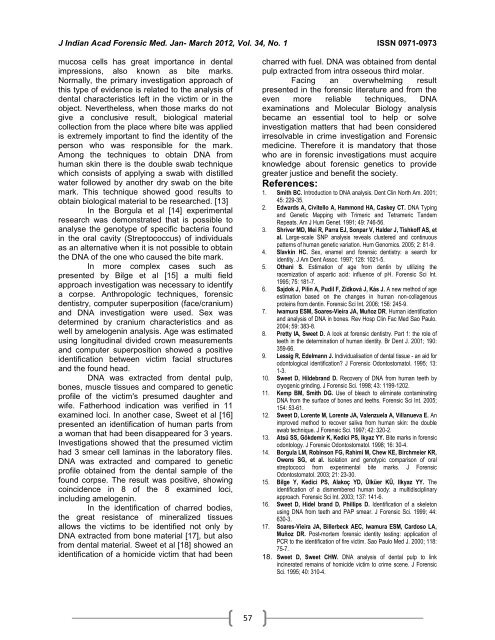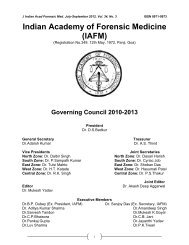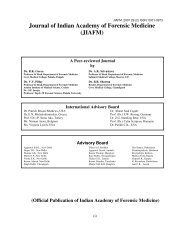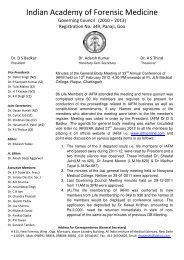Indian Academy of Forensic Medicine (IAFM) - Official website of IAFM
Indian Academy of Forensic Medicine (IAFM) - Official website of IAFM
Indian Academy of Forensic Medicine (IAFM) - Official website of IAFM
Create successful ePaper yourself
Turn your PDF publications into a flip-book with our unique Google optimized e-Paper software.
J <strong>Indian</strong> Acad <strong>Forensic</strong> Med. Jan- March 2012, Vol. 34, No. 1 ISSN 0971-0973<br />
mucosa cells has great importance in dental<br />
impressions, also known as bite marks.<br />
Normally, the primary investigation approach <strong>of</strong><br />
this type <strong>of</strong> evidence is related to the analysis <strong>of</strong><br />
dental characteristics left in the victim or in the<br />
object. Nevertheless, when those marks do not<br />
give a conclusive result, biological material<br />
collection from the place where bite was applied<br />
is extremely important to find the identity <strong>of</strong> the<br />
person who was responsible for the mark.<br />
Among the techniques to obtain DNA from<br />
human skin there is the double swab technique<br />
which consists <strong>of</strong> applying a swab with distilled<br />
water followed by another dry swab on the bite<br />
mark. This technique showed good results to<br />
obtain biological material to be researched. [13]<br />
In the Borgula et al [14] experimental<br />
research was demonstrated that is possible to<br />
analyse the genotype <strong>of</strong> specific bacteria found<br />
in the oral cavity (Streptococcus) <strong>of</strong> individuals<br />
as an alternative when it is not possible to obtain<br />
the DNA <strong>of</strong> the one who caused the bite mark.<br />
In more complex cases such as<br />
presented by Bilge et al [15] a multi field<br />
approach investigation was necessary to identify<br />
a corpse. Anthropologic techniques, forensic<br />
dentistry, computer superposition (face/cranium)<br />
and DNA investigation were used. Sex was<br />
determined by cranium characteristics and as<br />
well by amelogenin analysis. Age was estimated<br />
using longitudinal divided crown measurements<br />
and computer superposition showed a positive<br />
identification between victim facial structures<br />
and the found head.<br />
DNA was extracted from dental pulp,<br />
bones, muscle tissues and compared to genetic<br />
pr<strong>of</strong>ile <strong>of</strong> the victim's presumed daughter and<br />
wife. Fatherhood indication was verified in 11<br />
examined loci. In another case, Sweet et al [16]<br />
presented an identification <strong>of</strong> human parts from<br />
a woman that had been disappeared for 3 years.<br />
Investigations showed that the presumed victim<br />
had 3 smear cell laminas in the laboratory files.<br />
DNA was extracted and compared to genetic<br />
pr<strong>of</strong>ile obtained from the dental sample <strong>of</strong> the<br />
found corpse. The result was positive, showing<br />
coincidence in 8 <strong>of</strong> the 8 examined loci,<br />
including amelogenin.<br />
In the identification <strong>of</strong> charred bodies,<br />
the great resistance <strong>of</strong> mineralized tissues<br />
allows the victims to be identified not only by<br />
DNA extracted from bone material [17], but also<br />
from dental material. Sweet et al [18] showed an<br />
identification <strong>of</strong> a homicide victim that had been<br />
57<br />
charred with fuel. DNA was obtained from dental<br />
pulp extracted from intra osseous third molar.<br />
Facing an overwhelming result<br />
presented in the forensic literature and from the<br />
even more reliable techniques, DNA<br />
examinations and Molecular Biology analysis<br />
became an essential tool to help or solve<br />
investigation matters that had been considered<br />
irresolvable in crime investigation and <strong>Forensic</strong><br />
medicine. Therefore it is mandatory that those<br />
who are in forensic investigations must acquire<br />
knowledge about forensic genetics to provide<br />
greater justice and benefit the society.<br />
References:<br />
1. Smith BC. Introduction to DNA analysis. Dent Clin North Am. 2001;<br />
45: 229-35.<br />
2. Edwards A, Civitello A, Hammond HA, Caskey CT. DNA Typing<br />
and Genetic Mapping with Trimeric and Tetrameric Tandem<br />
Repeats. Am J Hum Genet. 1991; 49: 746-56.<br />
3. Shriver MD, Mei R, Parra EJ, Sonpar V, Halder J, Tishk<strong>of</strong>f AS, et<br />
al. Large-scale SNP analysis reveals clustered and continuous<br />
patterns <strong>of</strong> human genetic variation. Hum Genomics. 2005; 2: 81-9.<br />
4. Slavkin HC. Sex, enamel and forensic dentistry: a search for<br />
identity. J Am Dent Assoc. 1997; 128: 1021-5.<br />
5. Othani S. Estimation <strong>of</strong> age from dentin by utilizing the<br />
racemization <strong>of</strong> aspartic acid: influence <strong>of</strong> pH. <strong>Forensic</strong> Sci Int.<br />
1995; 75: 181-7.<br />
6. Sajdok J, Pilin A, Pudil F, Zídková J, Kás J. A new method <strong>of</strong> age<br />
estimation based on the changes in human non-collagenous<br />
proteins from dentin. <strong>Forensic</strong> Sci Int. 2006; 156: 245-9.<br />
7. Iwamura ESM, Soares-Vieira JA, Muñoz DR. Human identification<br />
and analysis <strong>of</strong> DNA in bones. Rev Hosp Clin Fac Med Sao Paulo.<br />
2004; 59: 383-8.<br />
8. Pretty IA, Sweet D. A look at forensic dentistry. Part 1: the role <strong>of</strong><br />
teeth in the determination <strong>of</strong> human identity. Br Dent J. 2001; 190:<br />
359-66.<br />
9. Lessig R, Edelmann J. Individualisation <strong>of</strong> dental tissue - an aid for<br />
odontological identification? J <strong>Forensic</strong> Odontostomatol. 1995; 13:<br />
1-3.<br />
10. Sweet D, Hildebrand D. Recovery <strong>of</strong> DNA from human teeth by<br />
cryogenic grinding. J <strong>Forensic</strong> Sci. 1998; 43: 1199-1202.<br />
11. Kemp BM, Smith DG. Use <strong>of</strong> bleach to eliminate contaminating<br />
DNA from the surface <strong>of</strong> bones and teeths. <strong>Forensic</strong> Sci Int. 2005;<br />
154: 53-61.<br />
12. Sweet D, Lorente M, Lorente JA, Valenzuela A, Villanueva E. An<br />
improved method to recover saliva from human skin: the double<br />
swab technique. J <strong>Forensic</strong> Sci. 1997; 42: 320-2.<br />
13. Atsü SS, Gökdemir K, Kedici PS, Ikyaz YY. Bite marks in forensic<br />
odontology. J <strong>Forensic</strong> Odontostomatol. 1998; 16: 30-4.<br />
14. Borgula LM, Robinson FG, Rahimi M, Chew KE, Birchmeier KR,<br />
Owens SG, et al. Isolation and genotypic comparison <strong>of</strong> oral<br />
streptococci from experimental bite marks. J <strong>Forensic</strong><br />
Odontostomatol. 2003; 21: 23-30.<br />
15. Bilge Y, Kedici PS, Alakoç YD, Ûlküer KÛ, Ilkyaz YY. The<br />
identification <strong>of</strong> a dismembered human body: a multidisciplinary<br />
approach. <strong>Forensic</strong> Sci Int. 2003; 137: 141-6.<br />
16. Sweet D, Hidel brand D, Phillips D. Identification <strong>of</strong> a skeleton<br />
using DNA from teeth and PAP smear. J <strong>Forensic</strong> Sci. 1999; 44:<br />
630-3.<br />
17. Soares-Vieira JA, Billerbeck AEC, Iwamura ESM, Cardoso LA,<br />
Muñoz DR. Post-mortem forensic identity testing: application <strong>of</strong><br />
PCR to the identification <strong>of</strong> fire victim. Sao Paulo Med J. 2000; 118:<br />
75-7.<br />
18. Sweet D, Sweet CHW. DNA analysis <strong>of</strong> dental pulp to link<br />
incinerated remains <strong>of</strong> homicide victim to crime scene. J <strong>Forensic</strong><br />
Sci. 1995; 40: 310-4.









